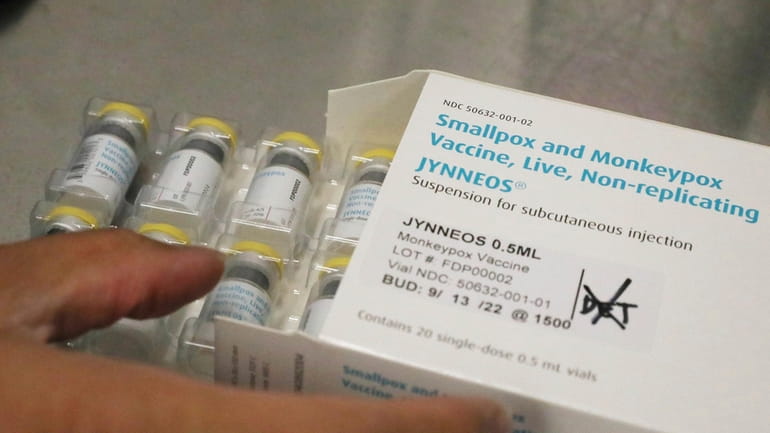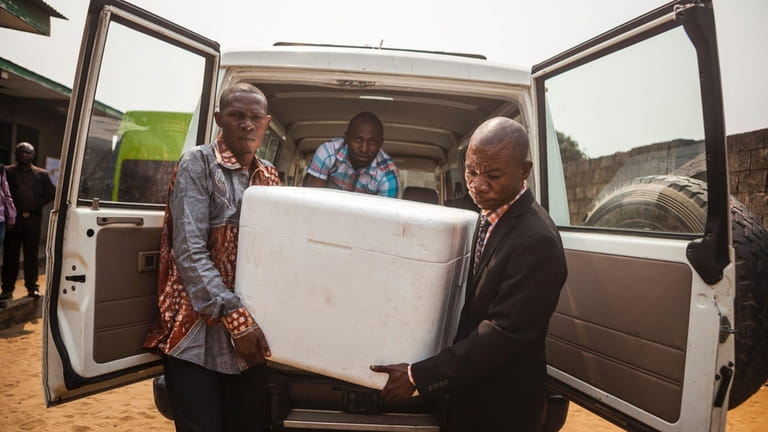Stretching monkeypox shots by giving smaller doses considered

A new strategy to combat monkeypox splits the Jynneos vaccine into five doses, based on one study — from 2015. Credit: AP/Lea Suzuki
Yellow fever was tearing through the Democratic Republic of the Congo in 2016, without enough vaccine to stop the spread.
About the same time, there was a global campaign to stamp out polio, and India lacked enough polio vaccine to go around.
So vaccinators in both nations turned to a technique called fractionating — uncommon in the United States — in which a standard dose is split into parts to allow more people to achieve at least some protection.
Long Island and the rest of the nation — currently in a public health emergency over monkeypox — could soon learn whether using fractional doses of the scarce monkeypox vaccine, given instead via a more difficult injection method, can help slow the virus' exponential spread.
On Tuesday, the U.S. Food and Drug Administration approved fractional doses of the anti-pox vaccine Jynneos to meet high demand as a global outbreak of monkeypox continues. Fractionating is typically done by splitting each dose into five parts, yielding five times as many shots, according to Dr. William Moss, executive director of the International Vaccine Access Center at the Johns Hopkins Bloomberg School of Public Health.
“I won’t say it’s really common, but this issue comes up when there’s obviously a vaccine shortage, so often in the midst of an outbreak or emergency,” he said, describing how fractionating has also been recommended by the World Health Organization for dealing with meningococcal outbreaks in Africa.
Not on Long Island — yet
Fractionating for monkeypox is not yet being used on Long Island, where each county's state-provided shots — nearly 11,000 have been allocated so far — are administered at more than a dozen clinics run by Nassau University Medical Center, Northwell Health, Stony Brook Medicine and Sun River Health, according to representatives of each organization and of Nassau and Suffolk counties. Most said that fractionating was under review.

Public employees unload boxes containing yellow fever vaccines in Kinshasa, capital of the Democratic Republic of the Congo, on July 20, 2016. Credit: AFP via Getty Images/Eduardo Soteras
At Sun River’s vaccine operation, full doses, each 0.5 mL, are still being given, because the government recommendations are so new, said chief operating officer Allison Dubois: “What we’re administering are the full doses until we get the clarity from the state about an official required change.”
Cadence Acquaviva, a state Department of Health spokeswoman, said Wednesday that the agency "is reviewing the new federal guidance and considering all options." New York City is also reviewing the guidance, said Michael Lanza, a city Health Department spokesman.
Acquaviva didn't respond to a follow-up email asking whether a vaccination clinic can decide on its own to fractionate doses, or whether the state must approve the technique's use.
Nationwide, appointments for the monkeypox shot have been scarce for months. Those slots have booked up almost immediately after becoming available online.
Fractionating could expand appointments fivefold. But it comes with a question: Can providing a fifth of a standard dose confer sufficient protection?
For monkeypox, fractional dosing is based on a single trial published in 2015. On a conference call last week, an FDA official, Dr. Peter Marks, defended relying on the trial, calling it reassuring and well-constructed. Robert Fenton, the new White House monkeypox coordinator, called it a “game changer” that “will significantly scale the volume of vaccine doses across the country.”
But the manufacturer of the Jynneos monkeypox vaccine, Bavarian Nordic, wrote to the federal government: “We do have some reservations," citing such concerns as "the very limited safety data available."
The number of monkeypox infections keeps rising exponentially. In the first 10 days of the month, cases overall roughly doubled in the United States, according to the website Our World in Data, which is run at Oxford University. New York, with 2,295 reported cases, is the epicenter of the U.S. outbreak of 11,177 reported cases so far. There are 33 infected Suffolk residents and 20 from Nassau, according to the state Health Department.
Dr. Anthony Fauci, the chief medical adviser to President Joe Biden, suggested last month that those who are at greatest risk in the current outbreak — men who have anonymous or random sex with other men, a current criteria to qualify for the vaccine — reduce their number of sexual partners.
“When you have a situation where you’re not protected, and you have a virus that’s circulating in the community, [it] is just prudent to just cool it for a while until you get that protection,” Fauci said.
As for who would actually split up the vaccine doses into fifths, the splitting would likely be done at the vaccination clinic, Moss said. One vial, which typically contains one single-use dose, would instead be drawn into five different syringes, he said.
But any unused vaccine — say, because someone doesn't show up to an appointment and no one else comes to get the shot — would spoil and need to be thrown out, Moss said.
Injection method takes more skill
When fractionating, the dose is generally injected into the skin — intradermally — rather than subcutaneously, meaning under the skin. That’s because there are more immune cells in superficial parts of the skin, resulting in a better immune response. It’s not done intradermally with regular doses because it’s harder to properly administer an intradermal shot than a subcutaneous one.
The Jynneos vaccine is given in two doses, four weeks apart, and a person returning for a second shot would generally get another fractionated dose if he got a fractionated first dose, Moss said.
Daniela Weiskopf, a research assistant professor at the La Jolla Institute for Immunology in San Diego, last year studied using a quarter of the recommended dose of Moderna's COVID-19 vaccine. Her conclusion: The lesser dose conferred about as much immunity as having naturally caught coronavirus but not as much immunity as getting the full recommended vaccine dose, 100 micrograms.
Fractional dosing for monkeypox is not without controversy.
Using a more difficult injection method requires precision, with little room for error. And some experts say fractionating here needs further research — because the Jynneos clinical trials were approved using the full dose, not a fifth of one.
“I think that would need further studies to carefully look at that,” she said.
For any vaccine, including for monkeypox, the standard dosage is chosen by balancing the desired immune response against the virus with potential side effects, Weiskopf said: “What you want is a dose that induces the best immune response with the lowest side effects, right? So you don’t want to just give as much as you can. You want to find the sweet spot.”
On Long Island, even if there were enough supply to meet demand, Sun River is facing a shortage of another sort: personnel to inject the shots into arms.
“Significant public health demand is still being impacted by recruitment and retention of support staff,” Dubois said. “We’re facing those same vacancies issues, so we don’t have unlimited capacity to scale up in these kinds of instances.”
Testing barrels found in Bethpage ... Opening statements in Trump trial ... Jets trade Zach Wilson ... Tulip festival
Testing barrels found in Bethpage ... Opening statements in Trump trial ... Jets trade Zach Wilson ... Tulip festival
